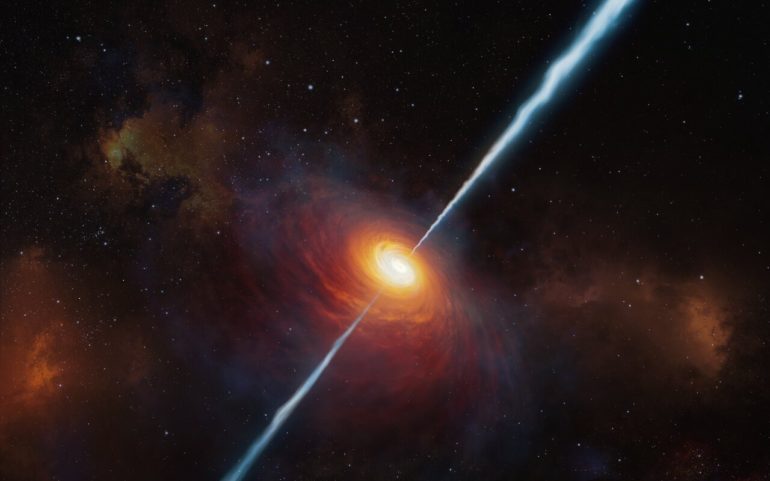With the help of the European Southern Observatory’s Very Large Telescope (ESO’s VLT), astronomers have discovered and studied in detail the most distant source of radio emission known to date. The source is a “radio-loud” quasar—a bright object with powerful jets emitting at radio wavelengths—that is so far away its light has taken 13 billion years to reach us. The discovery could provide important clues to help astronomers understand the early Universe.
Quasars are very bright objects that lie at the center of some galaxies and are powered by supermassive black holes. As the black hole consumes the surrounding gas, energy is released, allowing astronomers to spot them even when they are very far away.
The newly discovered quasar, nicknamed P172+18, is so distant that light from it has travelled for about 13 billion years to reach us: we see it as it was when the Universe was just around 780 million years old. While more distant quasars have been discovered, this is the first time astronomers have been able to identify the telltale signatures of radio jets in a quasar this early on in the history of the Universe. Only about 10% of quasars—which astronomers classify as “radio-loud”—have jets, which shine brightly at radio frequencies.
P172+18 is powered by a black hole about 300 million times more massive than our Sun that is consuming gas at a stunning rate. “The black hole is eating up matter very rapidly, growing in mass at one of the highest rates ever observed,” explains astronomer Chiara Mazzucchelli, Fellow at ESO in Chile, who led the discovery together with Eduardo Bañados of the Max Planck Institute for Astronomy in Germany.
The astronomers think that there’s a link between the rapid growth of supermassive black holes and the powerful radio jets spotted in quasars like P172+18. The jets are thought to be capable of disturbing the gas around the black hole, increasing the rate at which gas falls in. Therefore, studying radio-loud quasars can provide important insights into how black holes in the early Universe grew to their supermassive sizes so quickly after the Big Bang.
“I find it very exciting to discover ‘new’ black holes for the first time, and to provide one more building block to understand the primordial Universe, where we come from, and ultimately ourselves,” says Mazzucchelli.
P172+18 was first recognized as a far-away quasar, after having been previously identified as a radio source, at the Magellan Telescope at Las Campanas Observatory in Chile by Bañados and Mazzucchelli. “As soon as we got the data, we inspected it by eye, and we knew immediately that we had discovered the most distant radio-loud quasar known so far,” says Bañados.
However, owing to a short observation time, the team did not have enough data to study the object in detail. A flurry of observations with other telescopes followed, including with the X-shooter instrument on ESO’s VLT, which allowed them to dig deeper into the characteristics of this quasar, including determining key properties such as the mass of the black hole and how fast it’s eating up matter from its surroundings. Other telescopes that contributed to the study include the National Radio Astronomy Observatory’s Very Large Array and the Keck Telescope in the US.
While the team are excited about their discovery, to appear in The Astrophysical Journal, they believe this radio-loud quasar could be the first of many to be found, perhaps at even larger cosmological distances. “This discovery makes me optimistic and I believe—and hope—that the distance record will be broken soon,” says Bañados.
Observations with facilities such as ALMA, in which ESO is a partner, and with ESO’s upcoming Extremely Large Telescope (ELT) could help uncover and study more of these early-Universe objects in detail.
This research is presented in the paper “The discovery of a highly accreting, radio-loud quasar at z=6.82” to appear in The Astrophysical Journal.
Astronomers discover the most X-ray luminous high-redshift quasar
More information:
Research paper: www.eso.org/public/archives/re … eso2103/eso2103a.pdf
Citation:
Most distant quasar with powerful radio jets discovered (2021, March 8)
retrieved 8 March 2021
from https://phys.org/news/2021-03-distant-quasar-powerful-radio-jets.html
This document is subject to copyright. Apart from any fair dealing for the purpose of private study or research, no
part may be reproduced without the written permission. The content is provided for information purposes only.



